Technologies
Final Fantasy XVI’s Characters and Combat Hint at an Incredible Adventure
Preview: Square Enix reveals the story and battle system of the next entry in its iconic series before it hits PS5 this summer.
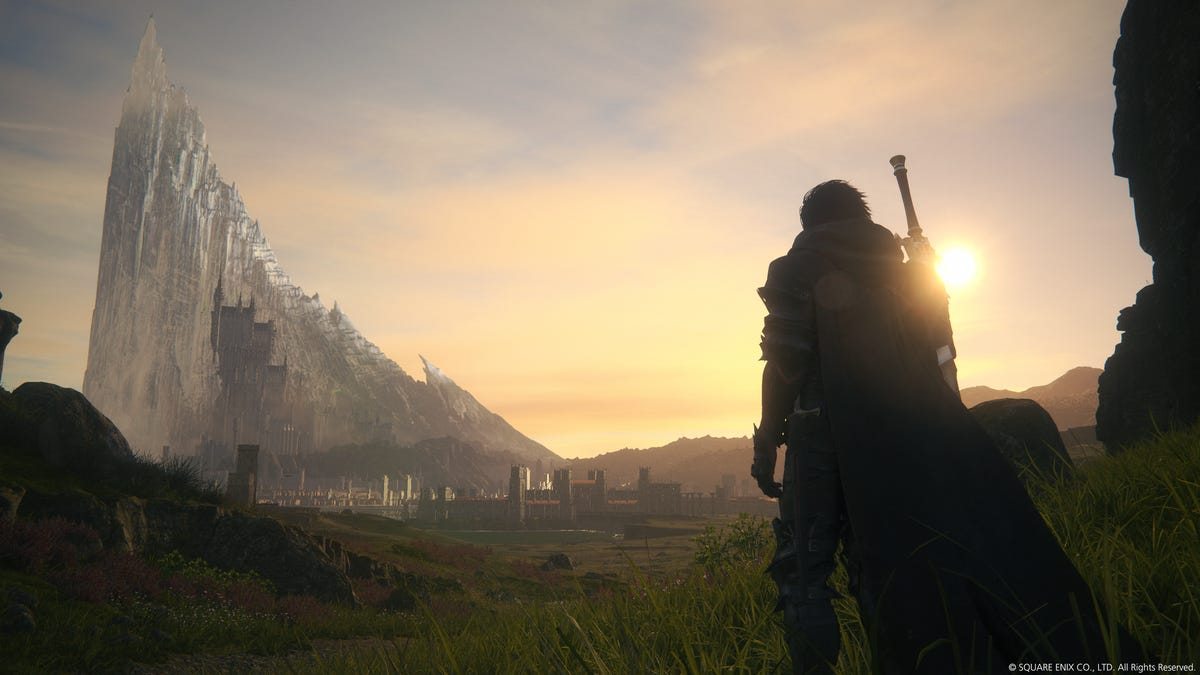
Every main numbered Final Fantasy game tells a new story in a fresh universe, giving each upcoming entry a powerful mystique. That sense is particularly strong with Final Fantasy XVI, which has been teased with spectacular, overwhelming trailers since it was unveiled with Sony’s PlayStation 5 in 2020.
The PS5 exclusive lands on June 22, and developer Square Enix lifted the curtain at a New York City preview event with a playable demo build of the game earlier this month. Acting as producer is Naoki Yoshida (AKA Yoshi-P), the charismatic figure credited with reviving massively multiplayer online RPG Final Fantasy XIV. He and his team gave us a primer on the story and world before letting us try out the game for the first time.
World at war
This RPG takes place in Valisthea, a world divided into six nations that depend on giant magic crystals — one of Final Fantasy’s recurring elements — for energy. As the game kicks off, this energy is badly depleted and conflict is brewing between Valisthea’s nations.
It’s more of a cold war due to the existence of Dominants — humans with the power to summon massive magical creatures known as Eikons. Like the dragons in Games of Thrones, the Eikons are basically this world’s weapons of mass destruction. Except all the nations have them, and they act as a deterrent to open war.
You play as Clive Rosfield, whose younger brother Joshua has control of the powerful Phoenix summon. After tragedy strikes, Clive is bound to another fiery Eikon, Ifrit, and goes on a quest for vengeance. This causes Eikons to battle each other for the first time, throwing off Valisthea’s delicate political balance and creating lots of collateral damage.


The Phoenix Eikon is central to the game’s epic tale.
Square EnixClive’s journey will take him through Valisthea’s seven nations — which are divided into segmented open areas rather than one big open world — with a shifting party of AI-controlled allies as backup (there wasn’t much exploration in the preview section though). You’ll also be able to dive into the history of Valisthea as much as you wish, Localization Director Michael-Christopher Koji Fox told CNET.
«We have a character that gathers lore; he will tell you about what’s going on in the game — characters, places, history, things like that,» said Koji Fox, whose previous Final Fantasy projects include IX and XIV. «It doesn’t affect the story, it doesn’t affect gameplay, but for those players that want to go deep and find out what happened 200 years ago, why these countries hate each other, you can go and do that.»
Dominating the Dominants
The playable section of our demo saw Clive and his ally Cidolfus Telamon (this game’s Cid, a recurring name in the series) making their way up a dark tower on the hunt for Benedikta Harman, a spy for a rival nation. Cid is the Dominant of lightning-summoning Ramuh, while Benedikta is linked to terrifying wind elemental Garuda.
Cid has beautifully styled hair and his voice will likely sound familiar — he’s voiced by Ralph Ineson, who appeared in Game of Thrones, Chernobyl and Willow and infuses his character with awesome gravitas. The fiery Benedikta is easily the most striking character design in the preview, and you know she’s a baddy because drops the f-bomb.
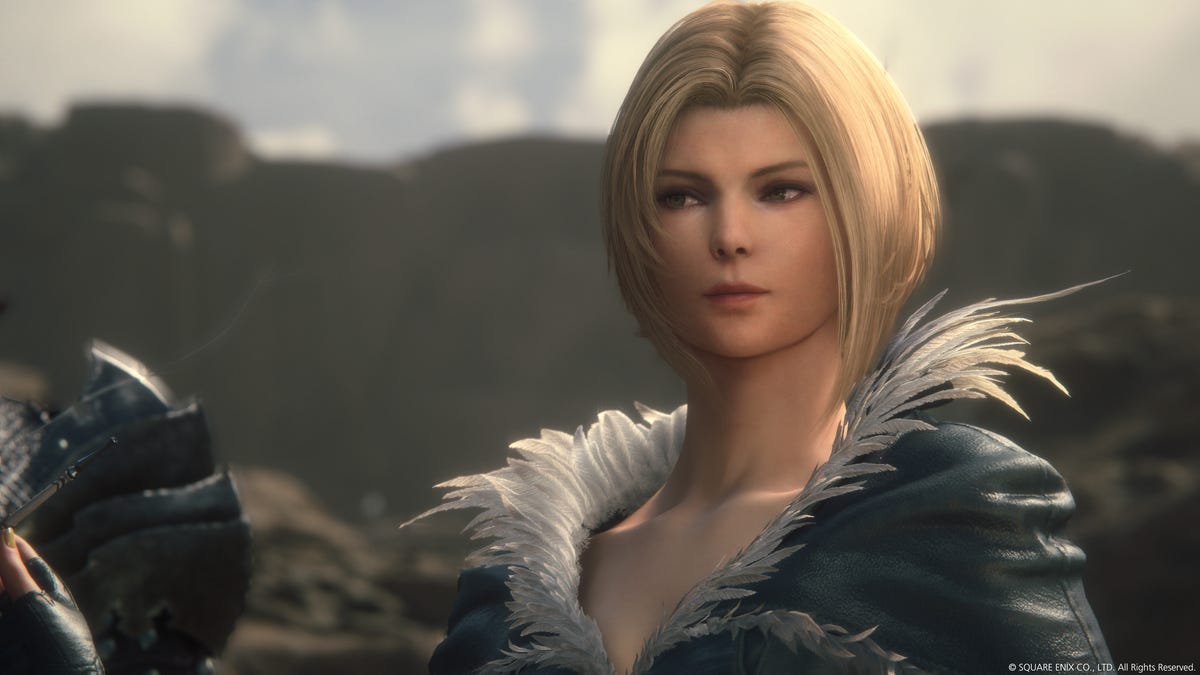

Benedikta is a pretty intense rival for Clive.
Square EnixThese Dominants humanize the political conflict, and their differing statuses within their own kingdoms hint at the varying cultures and attitudes across this world. This section occurs a few hours into the game, though there’s also a tutorial where you play as a young, fresh-faced Clive to learn the basics of combat.
The dingy tower wasn’t exactly a visual showcase for the first PS5 Final Fantasy, which will let you choose between performance and fidelity modes in the finished game. However, this location did offer plenty of opportunities to explore the game’s real-time combat system as goons leapt out at every turn. Unlike Final Fantasy VII Remake, you don’t control your entire party directly — only Clive and his faithful canine companion Torgal (whom you can pet).
Tailoring your battles
Basic combat fits neatly in the action-RPG mold, with Clive able to employ a mixture of melee attacks, magic, dodging and blocking. Final Fantasy XVI’s battles move much more quickly than those old games though, and combat director Ryota Suzuki drew on his experience developing lightning-fast action game Devil May Cry 5 for this series evolution.
«The most important thing for Final Fantasy XVI was to make a system that is accessible to lots of different types of playing styles; more technical, stylish and for players that are not too into action,» Suzuki said via translator. «So we didn’t want it to be overwhelming.»
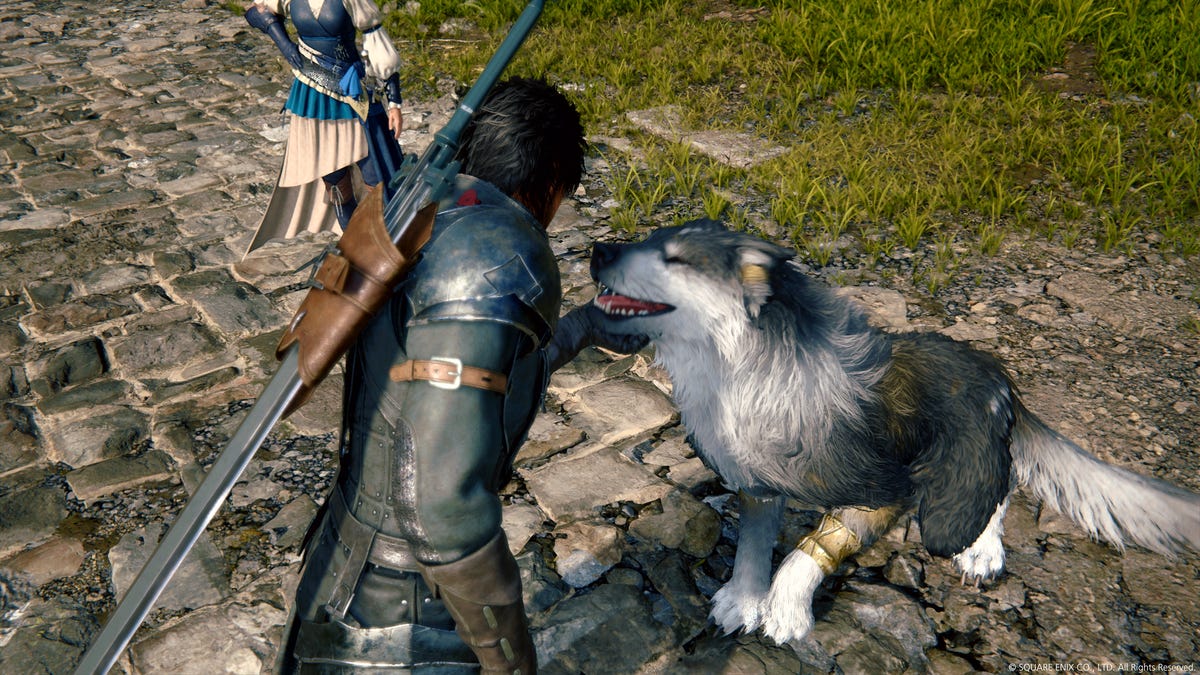

Torgal is an exceptionally good dog and useful in a fight.
Square EnixAdding to Final Fantasy XVI’s accessibility are the «Timely» accessories, which you can equip to simplify certain aspects of combat. These can let you pull off Clive’s most impressive combos by tapping the same button (instead of learning specific inputs), allow for easier dodging and make doggo pal Torgal battle automatically.
You can tailor this element based on which ones you equip, giving you a chance to get comfortable with different parts of the combat system at your own pace. The attack one had the most obvious impact, since unequipping it reduced Clive’s attacks from visually stunning Devil May Cry-style aerial ballets to basic thrusts and chops — you’ll have to learn a bunch of combos to achieve his most stylish moves normally.
Elemental Eikons
Your magical combat abilities are defined by the Eikon you have equipped, with Phoenix’s fire, Titan’s earth and Garuda’s wind were available in the demo, but it seems like Clive absorbs or copies these from other Dominants as he encounters them (it’s likely Garuda’s powers were unlocked early for the demo version). Earning experience lets you unlock or improve Clive’s elemental skills.
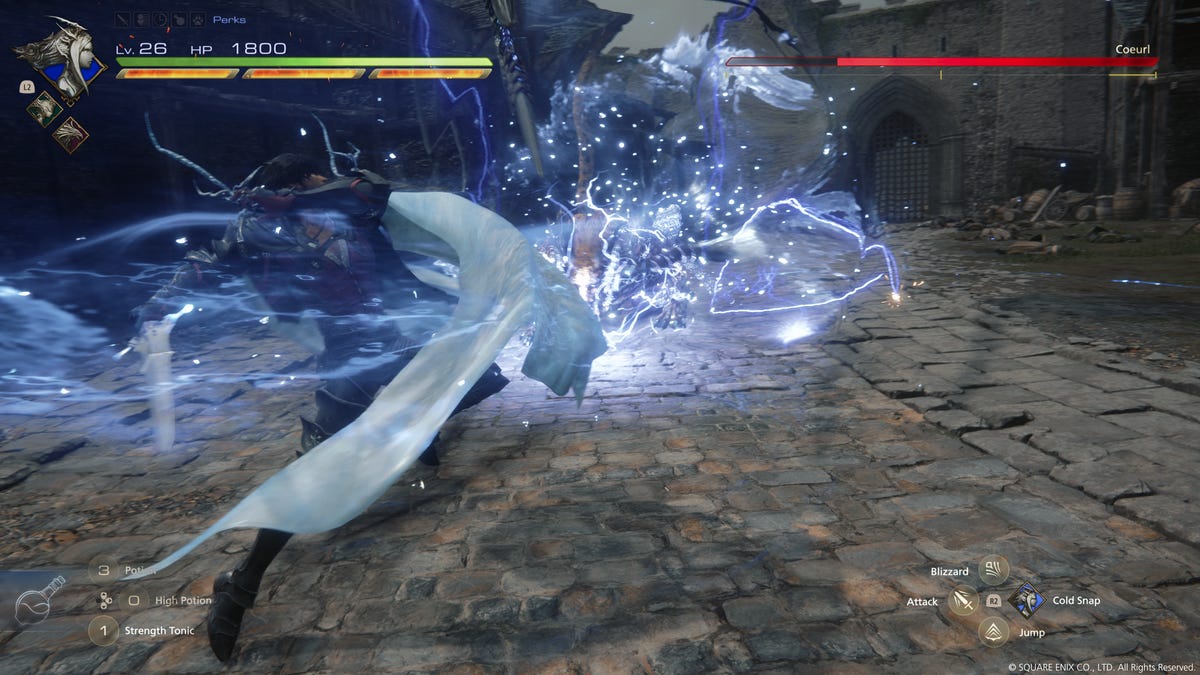

You can channel Eikons to employ elemental attacks in battle.
Square EnixYou can also switch between Eikons in battle, essentially allowing Clive to change character classes on the fly. It’s an evolution of the beloved job system that debuted in 1992’s Final Fantasy V, in which you assigned roles to characters and they learn those job-specific abilities through leveling up.
«It was my wish to take that job system and somehow replace jobs with Eikons, and recreate that system in a full action setting,» game director Hiroshi Takai, who worked on the fifth entry in the series, said through a translator.
«Making it something that’s very customizable and individual to each player … the Clive they have at the end and the palette they use in that final battle is different for every single person.»
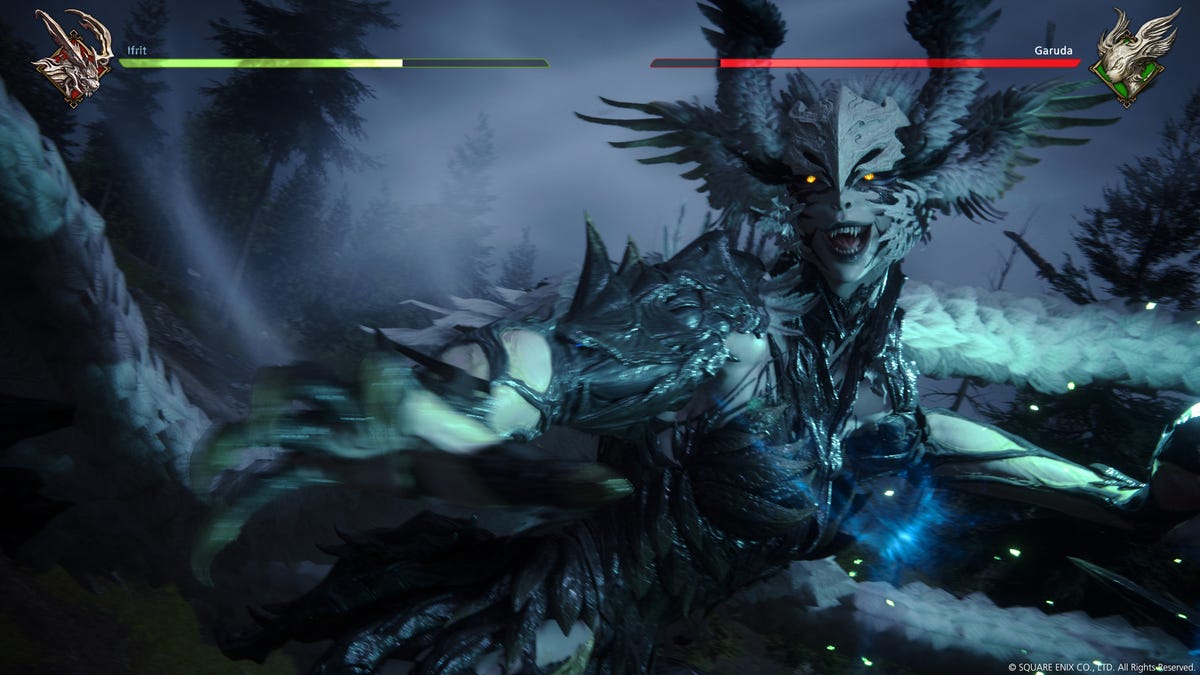

Garuda is awesome looking throughout the intense boss battle.
Square EnixFlipping between these elemental powers became increasingly natural as the demo progressed, with the mixture of these and the satisfying dodge system making the boss battle against Benedikta and her Eikon a joy to play. The smooth transitions between gameplay and cutscenes peppered the experience with that classic Final Fantasy melodrama without pulling control away for too long.
Battle of the titans
The final section of the demo took place a few hours further into the game, with Ifrit going up against Benedikta’s Garuda in an epic Godzilla vs Kong-style confrontation. It’s the kind of sequence that would have been a cutscene in older Final Fantasy games, but XVI makes it completely playable and extremely fun.
This battle felt completely different to normal combat, conveying an awesome sense of primordial power as the Eikons lay waste to an isolated part of Valisthea. Ifrit employs a mixture of beefy melee moves and fiery blasts against Garuda’s quick slashes and wind-based attacks. Projectiles also neutralize each other, which is a particularly cool touch.
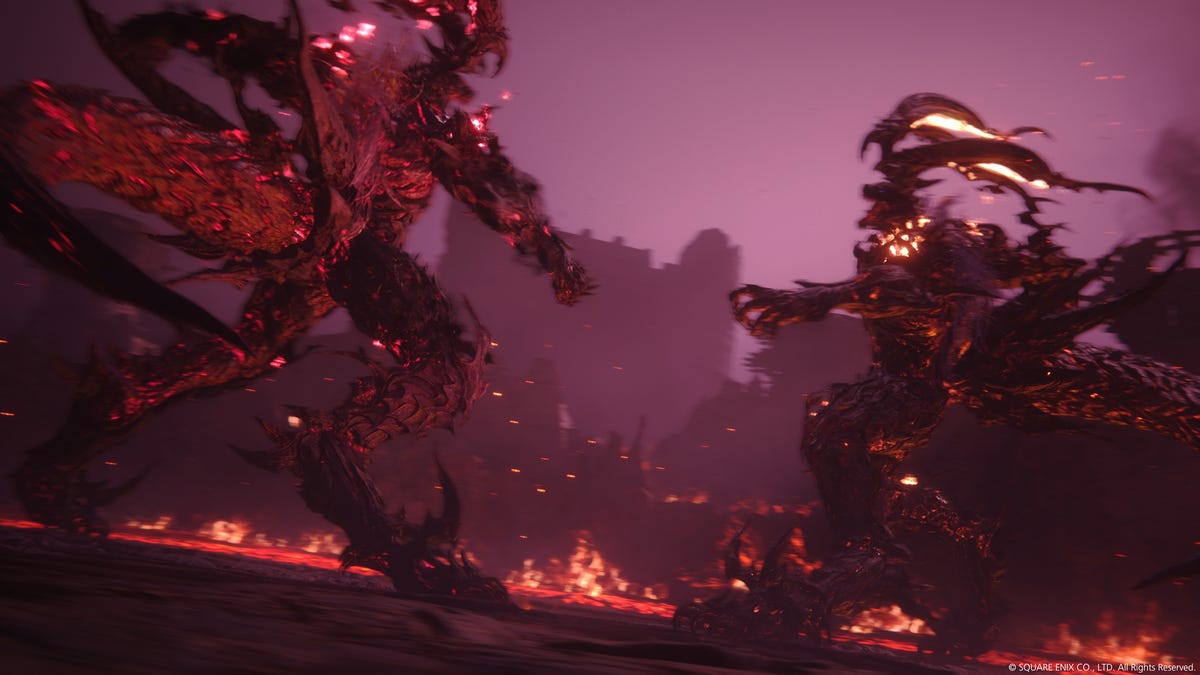

The Eikons are a force of nature, and their clashes make a huge mess.
Square EnixThe developers noted that the gameplay of these Eikon clashes will vary, hinting that you’ll have to battle each one differently depending on their elemental prowess, unique attributes and Clive’s relationship with the character who’s controlling them.
Even with the shift toward action-oriented battles, Final Fantasy XVI looks set to be an emotional roller coaster in the series’ grand tradition. Speaking through a translator, producer Naoki Yoshida wants players to feel thrilled and hopeful by the time they’re done with the game.
«When those end credits roll and the players experience the whole story, I want them to feel that they can move toward tomorrow, no matter what happened today,» he said.
Technologies
The Most Exciting Video Game Rumors and Leaks Ahead of 2026
Technologies
Today’s NYT Mini Crossword Answers for Wednesday, Dec. 17
Here are the answers for The New York Times Mini Crossword for Dec. 17.

Looking for the most recent Mini Crossword answer? Click here for today’s Mini Crossword hints, as well as our daily answers and hints for The New York Times Wordle, Strands, Connections and Connections: Sports Edition puzzles.
Need some help with today’s Mini Crossword? Read on. And if you could use some hints and guidance for daily solving, check out our Mini Crossword tips.
If you’re looking for today’s Wordle, Connections, Connections: Sports Edition and Strands answers, you can visit CNET’s NYT puzzle hints page.
Read more: Tips and Tricks for Solving The New York Times Mini Crossword
Let’s get to those Mini Crossword clues and answers.
Mini across clues and answers
1A clue: Nod (off)
Answer: DOZE
5A clue: Naval submarine in W.W. II
Answer: UBOAT
7A clue: Tricky thing to do on a busy highway
Answer: MERGE
8A clue: Heat-resistant glassware for cooking
Answer: PYREX
9A clue: Put into groups
Answer: SORT
Mini down clues and answers
1D clue: Break up with
Answer: DUMP
2D clue: Falls in line, so to speak
Answer: OBEYS
3D clue: Legendary vigilante who cuts a «Z» with his sword
Answer: ZORRO
4D clue: Rarin’ to go
Answer: EAGER
6D clue: Common reminder for an upcoming appointment
Answer: TEXT
Don’t miss any of our unbiased tech content and lab-based reviews. Add CNET as a preferred Google source.
Technologies
You Can Watch an Exclusive Avatar: Fire and Ash Scene on TikTok Right Now
Disney and TikTok partner on an immersive content hub for James Cameron’s latest movie about the alien Na’vi.
If you’re not quite ready to head to the theater to watch Avatar: Fire and Ash, an exclusive scene preview might sell you on the visual spectacle. As part of a new collaboration with the social media giant, Disney is posting snippets of its new movie to its TikTok account.
This scene isn’t part of any trailer and won’t be posted to other social media accounts, making TikTok the only place you can view it — unless you buy a movie ticket. A first look at the new movie’s scenes isn’t the only Avatar-related bonus on the social media platform right now, either. TikTok has partnered with the house of mouse to bring an entire «immersive content hub» to the app.
A special section of TikTok includes quizzes and educational videos that explore the alien world of Pandora shown off in the movies. On TikTok, you can take a personality quiz to find out what Na’vi clan you most closely align with and unlock a special profile picture border to use on your account.
Science and fiction blend together with a series of videos from real doctors who explain the basis for some of Avatar’s world-building. If you want to learn about exoplanets or how realistic the anatomy of the movie’s alien animals is, these videos will feed your brain while still providing entertainment value.
Perhaps the most enticing part of Disney’s latest social media collaboration is the opportunity for fans to win prizes and trips. TikTok creators who make edits with the #TikTokAvatarContest hashtag are entered into a competition to win Avatar merchandise. The biggest winners will be able to take a trip to visual effects studio Wētā Workshop in New Zealand or visit Avatar director James Cameron’s Lightstorm Entertainment Studio in Los Angeles.
Avatar: Fire and Ash is the third installment in director Cameron’s cinematic passion project. While the first Avatar movie was released in 2009, Cameron didn’t release another entry in the franchise until 2022. In total, there is a five-movie arc planned for the indigo alien Na’vi on the moon of Pandora.
The Avatar movies are known for pushing the boundaries of CGI visual effects in cinema. They are also historically big winners at the box office: the original Avatar is the highest-grossing film of all time, earning $2.9 billion across its theatrical releases. Its sequel, Avatar: The Way of Water, is the third-highest-grossing film of all time, trailing Avengers: Endgame. You can stream those movies on Disney Plus.
It remains to be seen whether Avatar: Fire and Ash will financially live up to its predecessors. The film currently has mixed reviews from critics on Rotten Tomatoes.
-

 Technologies3 года ago
Technologies3 года agoTech Companies Need to Be Held Accountable for Security, Experts Say
-

 Technologies3 года ago
Technologies3 года agoBest Handheld Game Console in 2023
-

 Technologies3 года ago
Technologies3 года agoTighten Up Your VR Game With the Best Head Straps for Quest 2
-

 Technologies4 года ago
Technologies4 года agoBlack Friday 2021: The best deals on TVs, headphones, kitchenware, and more
-

 Technologies4 года ago
Technologies4 года agoVerum, Wickr and Threema: next generation secured messengers
-

 Technologies4 года ago
Technologies4 года agoGoogle to require vaccinations as Silicon Valley rethinks return-to-office policies
-

 Technologies4 года ago
Technologies4 года agoOlivia Harlan Dekker for Verum Messenger
-

 Technologies4 года ago
Technologies4 года agoiPhone 13 event: How to watch Apple’s big announcement tomorrow

